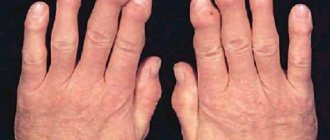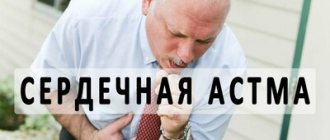A condition in which the rhythm, frequency and depth of breathing is disrupted, and a feeling of air deficiency occurs, is called shortness of breath. The causes and treatment of this disorder can be very diverse. Shortness of breath can occur under various conditions. So, for example, there is shortness of breath when talking, shortness of breath when lying down, after sleep, shortness of breath at rest, etc. The breathing of a person with shortness of breath is frequent and noisy; it is these manifestations that give others reason to assume the presence of shortness of breath. Shortness of breath can be a consequence of quite serious diseases, therefore, when it appears, it is necessary to contact a specialist as quickly as possible, who will competently explain what shortness of breath is and how it manifests itself, and also prescribe a comprehensive diagnostic examination to identify the causes of its occurrence.
The Therapy Center of the Yusupov Hospital offers high-quality diagnostics and effective treatment of diseases accompanied by shortness of breath. If necessary, a pulmonologist can be called to your home.
Types of shortness of breath
Shortness of breath can be of several types:
- inspiratory (shortness of breath while inhaling), expiratory (during exhalation) and mixed (with difficulty in inhaling and exhaling);
- tachypnea (increased shallow breathing) and bradypnea (decreased breathing);
- physiological - transient, reversible intensification of breathing (shortness of breath during physical exertion). The causes of shortness of breath in this case are that it is an adequate adaptive response to stress, injury, or an objectively low level of oxygen in the inhaled air;
- pathological (in case of airway obstructions due to bad habits, cardiovascular failure, obesity, lung diseases, hematopoietic system, etc.).
Complications after difficulty breathing
People suffering from shortness of breath are limited in daily and social activities. This affects independence and reduces social significance. As it progresses, anxiety and worry arise. Sleep disturbance occurs and depression develops. Chronic heart failure is especially dangerous.
Metabolism and gas exchange disorders in the body can lead to dangerous complications:
- decrease in blood pressure;
- pulmonary edema;
- persistent breathing problems;
- attacks of suffocation against the background of cardiac cardiac asthma.
As the disease progresses, the following disorders are observed:
- blueness of the limbs and lips (cyanosis);
- suffocating cough at night;
- gurgling sensation in the heart area;
- the appearance of profuse cold sweat;
- development of pulmonary emphysema;
- discharge of sputum with traces of blood;
- decreased elasticity of lung tissue and blood vessels.
Pulmonary edema and heart failure are very serious and dangerous pathologies for human health. If shortness of breath occurs at rest, you should immediately seek medical help.
Why does shortness of breath occur?
If a person suddenly develops severe shortness of breath, the reasons can be very diverse. Most often it is caused by the following conditions:
- cardiovascular diseases – due to these pathologies, blood circulation is impaired. Internal organs suffer from a lack of oxygen, and carbon dioxide accumulates in the blood. The body’s reaction to this condition is increased breathing: a larger volume of air is pumped through the lungs per unit of time. In the supine position and after physical activity, shortness of breath associated with heart pathology occurs or intensifies. Severe shortness of breath occurs with the patient sitting or half-sitting. This kind of shortness of breath is characterized by difficulty breathing;
- diseases of the respiratory system - the appearance of shortness of breath is associated with obstacles to the passage of air through the respiratory tract (for example, narrowing of the lumen of the bronchi). Therefore, shortness of breath is considered a typical symptom of bronchial asthma. With this disease, the patient experiences difficulty in exhaling. In addition, shortness of breath occurs in cases where the respiratory surface of the lung tissue is reduced. Such a decrease is accompanied by an increase in the intensity of lung function, i.e. frequent inhalation, which is necessary to maintain the required amount of oxygen entering the blood. The list of pathologies of the respiratory system accompanied by shortness of breath includes neoplasms, pneumonia, chronic obstructive pulmonary disease, etc.;
- anemia - even with normal activity of the lungs and heart, a deficiency of hemoglobin and red blood cells leads to insufficient provision of the organs with the necessary amount of oxygen. To compensate for this disorder, the body increases its breathing rate;
- neuroses and panic attacks - in these cases, clinical examinations do not reveal the presence of cardiovascular and pulmonary pathologies, but subjectively the patient suffers from lack of air, and the appearance of psycho-emotional changes provokes increased breathing, which causes shortness of breath;
- various tumors – shortness of breath occurs with a tumor of the thalamus, intestinal tumors, etc.;
- problems with the gastrointestinal tract. For example, hoarseness, cough, shortness of breath with esophagitis are characteristic symptoms;
- obesity and diabetes are common causes of shortness of breath.
Which doctor should I contact if I have shortness of breath?
If this clinical manifestation is regular, you should first visit your doctor. He will conduct an examination, collect anamnesis - and, based on the information received, send the patient to an appointment with a specialist in pulmonology, cariology, hematology, neurology or endocrinology.
If a patient has a traumatic injury to the chest, he should consult a traumatologist. In cases where shortness of breath is part of an emergency condition - it appears suddenly and sharply - you should immediately call an ambulance.
Shortness of breath in people of different age categories
Shortness of breath can occur in people of all ages, from infants to the elderly.
In children, shortness of breath can be both physiological and pathological. The appearance of physiological shortness of breath is caused by physical exertion or high anxiety, which is considered normal. When the respiratory system is immature, pathological shortness of breath occurs in the infant. How to determine the type of shortness of breath and its causes is decided by the pediatrician, selecting the necessary diagnostic methods.
In old age, people's tolerance to physical activity decreases and the efficiency of the respiratory system decreases. Due to age-related changes, the physical strength of the respiratory muscles decreases, as a result of which gas exchange worsens and normal breathing becomes difficult. In addition, older people tend to have diseases of the cardiovascular system and lungs, which lead to shortness of breath. Most often, they do not pay attention to this symptom for a long time, so the diseases that accompany it are diagnosed at advanced stages. As a result, treatment becomes more difficult, the quality of life and its duration are significantly reduced. So it is better to immediately seek medical help if shortness of breath occurs in older people, without waiting for the condition to worsen.
The best pulmonologists in Moscow - Doctor of Medical Sciences, Professor Alexander Vyacheslavovich Averyanov, Candidate of Medical Sciences Alexander Evgenievich Shuganov are receiving appointments at the therapy center of the Yusupov Hospital. Klina is equipped with innovative high-tech equipment for conducting the most modern diagnostic studies. Thanks to an integrated approach involving specialized specialists in various fields, our doctors identify the exact cause of shortness of breath and select an effective treatment regimen, taking into account the individual characteristics of each patient.
Prevention and recommendations for shortness of breath
Physiological shortness of breath goes away on its own after the person has rested. However, if the problem arose acutely and suddenly, the following measures should be taken to alleviate his condition:
- Calm down and sit on a sofa or chair, comfortably resting your back;
- Remove or unfasten tight clothing, a belt that is too tight;
- Provide fresh air by opening a window or door;
- Humidify the air by hanging a pre-wetted sheet near the patient;
- Offer a herbal sedative.
If a person knows about his illness and he has drugs that alleviate his condition, he should be offered to drink them. If he does not feel better within fifteen minutes, he will have to call an ambulance.
There is no specific prevention in this case. However, you can minimize the risk of developing this condition by following these rules:
- Maintaining an active, healthy lifestyle;
- Avoiding excessive physical activity and stress;
- Body weight control;
- Timely treatment of diseases;
- Systematic completion of preventive studies.
Remember: lack of air can be a sign of serious pathological conditions. That is why CELT specialists recommend promptly finding out its causes and taking appropriate measures!
Make an appointment through the application or by calling +7 +7 We work every day:
- Monday—Friday: 8.00—20.00
- Saturday: 8.00–18.00
- Sunday is a day off
The nearest metro and MCC stations to the clinic:
- Highway of Enthusiasts or Perovo
- Partisan
- Enthusiast Highway
Driving directions
What is shortness of breath in humans: symptoms
The occurrence of shortness of breath in the initial stages of damage to the cardiovascular and respiratory systems is associated with physical exertion (for example, when the patient climbs up the stairs). As the pathology progresses, shortness of breath and fatigue appear even with a slight load (walking on a flat surface, tying shoelaces, etc.), as well as at rest.
Patients perceive shortness of breath quite subjectively. It may be accompanied by the following symptoms:
- difficulty breathing (inhalation/exhalation);
- compression in the chest;
- feeling of congestion in the chest area;
- tightness in the chest;
- feeling of lack of air;
- inability to take a deep breath or exhale completely;
- suffocation.
Diseases that cause lack of air
| Diseases | Causes, symptoms |
| Cardiological | Patients suffering from pathological conditions characterized by heart rhythm disturbances complain of shortness of breath and lack of air:
People suffer from it in diseases characterized by a lack of blood supply to the myocardium: angina pectoris, ischemia. The severity of the feeling of lack of air depends on the form and degree of insufficiency: in mild cases it is recorded under minor loads or in stressful situations. The problem is manifested by a lack of oxygen and rapid breathing when doing work or while walking. Other symptoms include cyanosis, chest pain, and swelling of the legs. |
| Pleurisy | A feeling of lack of air develops during inflammatory processes of the pleural layers, accompanied by the appearance of fibrin on their surface or the accumulation of exudate in the cavity. Breathing disorders occur due to severe pain of an acute stabbing or dull pulling nature: the patient tries not to inhale deeply so as not to experience them. The above is accompanied by fever, chills, and cough. |
| Laryngeal stenosis | The most common triggering factor for lack of air is pathologies that provoke obstructions and, as a result, limited oxygen supply. This is typical for acute and chronic stenosis:
|
| Lungs | Inflammatory and diffuse lesions of the lung tissue - initiate deficiency due to the fact that part of the lungs is “switched off” from the breathing process. This happens when:
|
| Foreign bodies in the respiratory tract | Blocking the airways with foreign objects can not only make breathing difficult, but also make it impossible. The person feels suffocated, restless, and takes a position in which he can at least somehow breathe. The symptom develops suddenly after accidentally inhaling an object and is accompanied by coughing, lacrimation, and intense salivation. |
| Pulmonary and pleural neoplasms of malignant etiology | Respiratory disorders are accompanied by a complex of specific symptoms, depending on the location of the neoplasia. Common to all are rapid fatigue, appetite disturbances, and rapid loss of body weight. A similar thing happens with pleural cancer or lung adenocarcinoma, in which malignant cells spread along the walls of the alveoli and bronchioles. |
| Traumatic injuries to the lungs and chest | This type of injury is called thoracic. These include:
|
Shortness of breath: diagnosis
Diagnosis of the underlying pathology that provoked shortness of breath is carried out using the following research methods:
- general examination (general medical examination, counting the frequency of respiratory movements of the chest, listening to the lungs with a phonendoscope);
- general blood test;
- chest radiography;
- computed tomography of the chest;
- spirometry (spirography) – to assess air flow through the respiratory tract and the ability of the lungs to expand;
- tests using a bronchodilator - spirometry is performed before and after inhalation with a bronchodilator drug. This study allows us to evaluate the reversibility of bronchial narrowing;
- bronchoprovocation test - spirometry is performed before and after inhalation of histamine and methacholine. It is carried out to detect increased sensitivity of the bronchi, which causes bronchospasms;
- studies of the gas composition of the blood (the level of tension in the blood of carbon dioxide, oxygen is determined, the saturation of the blood with oxygen is assessed);
- body plethysmography – allows you to evaluate the function of external respiration. It is used to assess all volumes and capacities of the lungs, incl. those that spirography cannot determine;
- electrocardiography (ECG), echocardiography (ultrasound of the heart, echocardiography) - allows you to assess the functional state of the heart and pressure in the pulmonary artery system;
- fiberoptic bronchoscopy is a study that is used to examine the mucous membrane of the bronchi from the inside and study its cellular composition with a special preparation. The use of this method is advisable for patients with an unclear diagnosis. Allows you to exclude other possible diseases with similar symptoms;
- angiopulmonography – during the procedure the blood vessels of the lungs are examined;
- lung biopsy;
- consultations with a pulmonologist, cardiologist.
What to do if you have severe shortness of breath?
Noninvasive ventilation (NIV) provides relief for increased breathing needs. This procedure is less useful for patients with defects in oxygen diffusion in the alveolar arteries. The most effective component of pulmonary rehabilitation is special breathing exercises.
Recommendations to follow in case of severe shortness of breath:
- If you have serious breathing problems, it is better to sleep with the head of the bed raised. This will help the lungs expand and promote drainage of secretions.
- While sitting, lean forward on your elbows. This will also help your lungs expand and make breathing easier.
- To reduce anxiety, you can use relaxation techniques (take slow, even, deep breaths and try to focus on pleasant things).
- Take medications strictly as prescribed by your doctor.
- If you experience side effects from your medications, especially if they are severe, tell your doctor or emergency team members.
- Use pursed-lip breathing when you feel short of breath. Inhale through your nose and exhale very slowly through your mouth, pursing your lips slightly. The exhalation should last twice as long as the inhalation.
- If you experience sudden breathing problems, you should open a window, move to another room where there are fewer people, or go outside.
- Nicotine and other chemicals in cigarettes can make shortness of breath worse. Electronic cigarettes also contain nicotine.
- Cold air and using fans to blow air onto the face can significantly improve shortness of breath. Supplemental oxygen has only been shown to be beneficial in hypoxic patients.
Simple but effective recommendations help improve your shortness of breath. Additional measures are aimed at reducing anxiety and providing an increased sense of control.
There are a huge number of reasons for shortness of breath. It is impossible to determine on your own whether it is a symptom of a serious illness. Only a highly qualified specialist can determine which organ disease caused the pathology and prescribe the appropriate examination. Make an appointment with your doctor to determine the cause of your discomfort.
sign up for a consultation
Shortness of breath: treatment
Pulmonologists at the Yusupov Hospital Therapy Center select an individual drug therapy regimen for each patient, depending on the disease that provoked the onset of shortness of breath.
The clinic’s rehabilitators draw up a plan for physical training and pulmonary rehabilitation to increase the patient’s tolerance to physical activity, and prescribe breathing exercises using various methods (diaphragmatic breathing, inflating balloons, blowing air through a tube, etc.) that train the respiratory muscles.
In severe cases, artificial ventilation is used.
Shortness of breath accompanies pathologies of various organs and systems of the human body. Therefore, each individual case requires specific therapy, aimed primarily at eliminating the underlying disease causing shortness of breath.
How to treat shortness of breath caused by cardiovascular diseases?
Patients with shortness of breath associated with cardiovascular diseases are prescribed therapy, the goals of which are:
- improve oxygen supply to the heart;
- increase cardiac output;
- reduce blood stagnation in the lungs.
The use of nitrates, glycosides, and diuretics is effective. Patients with heart failure are recommended to always have nitroglycerin available, which helps to immediately dilate the blood vessels of the heart muscle.
Oxygen therapy is used to replenish the lack of oxygen in the blood.
How to get rid of shortness of breath: first aid
Providing first aid for shortness of breath to a person suffering from heart disease involves doing the following:
- call an ambulance;
- before the arrival of doctors, it is necessary to ensure the flow of fresh air into the room where the patient is located by opening the window;
- the patient must be seated on a chair;
- remove the tie and scarf from the patient’s neck, unbutton the top buttons on the shirt;
- Place a nitrosorbide tablet under the patient’s tongue and give any diuretic.
How to cure shortness of breath associated with pulmonary diseases?
For shortness of breath caused by pulmonary pathologies, patients are advised to drink plenty of alkaline fluids (except for patients with pulmonary edema).
To relieve bronchospasm, selective β2-adrenergic agonists (salbutamol, fenoterol, terbutaline, formoterol, clenbuterol, salmeterol) are prescribed. M-cholinergic receptor blockers are effective for relaxing the muscles of the bronchi.
Patients suffering from bronchial asthma are prescribed inhalations with NSAIDs and steroid therapy.
Treatment of shortness of breath due to bronchitis involves the use of medications to separate sputum. These include:
- acetylcysteine;
- carbocysteine;
- bromhexine;
- ambroxol.
How to get rid of shortness of breath associated with allergies?
Every person suffering from allergic diseases should know what to take for shortness of breath of this etiology:
- diazolin;
- diphenhydramine;
- suprastin;
- tavegil;
- fenistil;
- claritin;
- desloratodine, etc.
As an additional therapy for shortness of breath caused by allergies, you can use traditional medicine: decoctions of plants that have an expectorant effect (from plantain, pine buds, coltsfoot), as well as hot foot baths.
How to deal with shortness of breath of a psychogenic nature?
Shortness of breath quite often accompanies mental disorders - melancholy, panic attack, depression. Patients suffering from these conditions are prescribed sedatives, antidepressants and tranquilizers. The use of therapeutic hypnosis is also effective. Treatment is prescribed exclusively by a psychotherapist.
Shortness of breath, especially at rest, is an alarming symptom that often manifests quite serious pathologies that require immediate examination and urgent medical care. Therefore, if such a respiratory disorder occurs, it is necessary to urgently visit your doctor. You can make an appointment with a therapist or pulmonologist at the Yusupov Hospital by calling the phone number listed on the clinic’s website.
Not enough air - treatment methods
If it is difficult to breathe for physiological reasons, but there are no diseases, no special therapy is required. Many people are interested in what to do if breathing is a little difficult, but there are no serious disorders in the body. To improve your well-being, you should use simple methods (ventilation, humidification, taking sedatives, agreed with the doctor).
Patients who have difficulty breathing due to certain diseases are prescribed complex treatment. Main goals of therapy:
- eliminate foci of infection and inflammation;
- clear the airways;
- speed up the discharge of sputum;
- improve blood composition;
- stabilize the functioning of the heart muscle;
- normalize the condition of blood vessels.
To eliminate lack of air during breathing, specialists at the KRH Dental & Medical clinic use effective and safe medications and prescribe effective procedures. Each patient is guaranteed attentive attention and an individual approach. After the treatment is completed, recommendations are given to correct the lifestyle and prevent the recurrence of the pathology.
Expiratory and inspiratory dyspnea
When walking, a person may experience both expiratory and inspiratory shortness of breath. In the first case, a person experiences difficulty exhaling, as the walls of the bronchi undergo certain changes or become spasms. Expiratory shortness of breath can accompany bronchial asthma, obstructive bronchitis, emphysema and other pathological processes in the organs of the respiratory system.
With inspiratory dyspnea, it is difficult for the patient to breathe. This pathological symptom can be provoked by pneumosclerosis, tuberculosis, cancer, bronchial asthma, laryngeal pathologies, etc.
In some cases, shortness of breath can be mixed, when a person experiences difficulty not only during inhalation, but also during exhalation.











